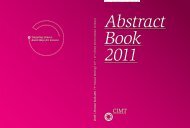Abstract Book 2010 - CIMT Annual Meeting
Abstract Book 2010 - CIMT Annual Meeting
Abstract Book 2010 - CIMT Annual Meeting
You also want an ePaper? Increase the reach of your titles
YUMPU automatically turns print PDFs into web optimized ePapers that Google loves.
034 Guidoboni | Immune monitoring<br />
Changes of immune cell infiltrates induced by dendritic cell<br />
vaccination in melanoma patients‘ tumor tissues:<br />
an immunohistochemical study<br />
Massimo Guidoboni 1 , Laura Ridolfi 1 , Annamaria Granato 1 , Massimiliano Petrini 1 , Laura<br />
Fiammenghi 1 , Valentina Ancarani 1 , Elena Pancisi 1 , Linda Valmorri 1 , Angela Riccobon 1 ,<br />
Roberta Gafà 2 , Giovanni Lanza 2 , Dino Amadori 3 , Ruggero Ridolfi 1<br />
1 Immunotherapy and Somatic Cell Therapy Unit, Istituto Scientifico Romagnolo per lo Studio e la Cura dei<br />
Tumori, Meldola (FC), Italy<br />
2 Department of Pathology, University of Ferrara, Italy<br />
3 Medical Oncology, Istituto Scientifico Romagnolo per lo Studio e la Cura dei Tumori, Meldola (FC), Italy<br />
We have been treated more than 40 patients in a<br />
phase I/II study of therapeutic vaccination using<br />
DC pulsed with autologous tumor lysate or homogenate<br />
in advanced melanoma. Objective responses<br />
are observed in a limited number of patients, clinical<br />
responses rates as evaluated by classical responses<br />
criteria are still disappointing, and we are not able<br />
to identify patients who will benefit from DC vaccination.<br />
Spontaneous and vaccine-induced antitumor<br />
immune responses have been extensively characterized<br />
in peripheral circulating compartment,<br />
and in some cases this approach predicted clinical<br />
response to immunotherapy; however, we do not<br />
know whether this translate into efficient immune<br />
cell recruiting in all tumor sites. To shed light on<br />
changes induced by DC vaccine on the composition<br />
of immune effectors in tumor sites, we evaluated<br />
tumor infiltrating lymphocytes (TILs) in 12<br />
tumor biopsies taken from 4 patients before and at<br />
different times after DC vaccination for metastatic<br />
melanoma. Two patients showed complete clinical<br />
responses (CR) after at least 6 courses of vaccine.<br />
In one of these patients DC vaccination induced<br />
huge amount of CD8+ activated cytotoxic lymphocytes<br />
(24,89 CD8+ TILs/100 melanoma cells)<br />
in one tumor site compared to prevaccine biopsy;<br />
however, negligible levels of CD8+ TILs together<br />
with considerable amount of CD4+ cells were found<br />
in one other relapsed site, suggesting that immune<br />
escape had occurred. The other patient showing<br />
CR underwent relapse and progressive surgical de-<br />
bulking of metachronous localizations led to surgical<br />
CR still lasting. Tumor biopsies taken after<br />
vaccination showed lower amount of CD8+ TILs<br />
than those collected before (2,13 and 1,38 vs 8,44<br />
CD8+ TILs/100 tumor cells), showing that complete<br />
surgical removal of „immune escaped“ lesions<br />
may lead to persistent CR in patients with good<br />
clinical status. One patient undergone progression<br />
after Ipilimumab failure showed considerable<br />
levels of CD8+ TILs. After 9 courses of DC vaccine<br />
with stable disease (SD), she relapsed and progressing<br />
lesion was removed, with decreased amount of<br />
tumor infiltrating CD8+ lymphocytes in this tumor<br />
site. The last patient has been vaccinated for 4 years<br />
with still lasting SD, and further tumor biopsies<br />
were taken to prepare additional doses of vaccine.<br />
Treatment induced lower increase of CD8+ TILs<br />
in postvaccine biopsies than those observed in the<br />
other patients (3,28 and 1,93 vs 1,12 CD8+ TILs/100<br />
tumor cells), suggesting that lower immune pressure<br />
might allow to reach an equilibrium between<br />
immune system and tumor which slow occurrence<br />
of immune escape. Although performed on a<br />
limited number of cases, this study firstly explored<br />
the possible role for „tissue immune monitoring“ in<br />
the clinical setting and strongly indicate its use to<br />
direct clinical decision in multimodal therapeutic<br />
approach.<br />
77



